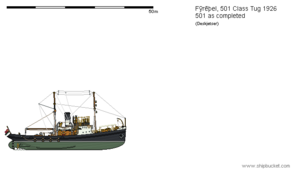501 Class Tug
The 501 class were developed by Beowulf ac Hama[1] (Hereafter: BaH) from 1924, in order to meet demands for a tugboat which would be able to respond to the fast changing nature of the modern harbour. To accomplish this task, the designers at BaH would look to the recent leaps in capability of marine diesel engines, which from the last 20 years had become a great deal more refined and capable; Thus, the allure of modern diesel powerplants in their comparatively rapid operational readiness, as opposed to older steam plants, along with their smaller size, meant BaH's latest design would be powered by diesel.
The result of BaH's efforts, was an all purpose tugboat, capable of readying in just a few short hours, and being able to carry out innumerable tasks in and around the harbour; From placing and recovering buoys, to guiding a myriad of vessels in and out of port.
The first of the class, 501, was built and launched from BaH's Middanᵹeard[2] slipways on the 29th of March 1926; 501 would serve under BaH for their operational use.
Other uses
Notable service of the 501 class was seen under the Holmweard[3], which sought to expand its capability for towing stricken vessels at the end of 1940. This was due to the recent explosion in growth of the Fȳish merchant marine, which in the last 20 years had seen the average tonnage of vessels increase by nearly 33%; To this end, 571 was acquired at the end of 1940 on the 6th of April, and 577 was acquired on the 10th of May 1946.
Throughout their careers they would be responsible for the salvaging of thousands of tons of shipping, both foreign and domestic, around the coastline of Fȳrland. At the end of 577's esteemed career in 1994, she was turned over to the Museum of Lifeboats in Brēcænburg, where she resides till this day.



